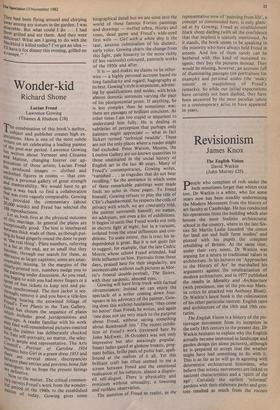Wonder-kid
Richard Shone
Lucian Freud
The combination of this book's author, subject and publisher creates high ex- eclations. Here is one of the most subtle writers on art celebrating a leading painter ;I! Ole post-war period. Lawrence Gowing has written about Vermeer and Cezanne and Matisse, changing forever our ap- preciation of those artists; Lucian Freud has produced images — clothed and unclothed figures in rooms — that con- stitute a personal gallery of great strength and. memorability. We would have to .go ctluite a
, Way back to find a collaboration
has was even vaguely comparable. Cowing 20 provided provided the commentary (about ','"°00 words) and Freud has selected the 188 reproductions. Let us look first at the physical outcome of this marriage. In general the plates are ebxe,ePtionally good. The'text is interleaved between thick wads of them, as though put- rits head gingerly round the door to peer the real thing'. Plate numbers, referring b° a list at the end, are so small that they ,ec°111e, through our search for them, as e otrusive as larger captions; some are unac- elt3:121,tahlY missing. In the margins of the ti,s-ariyprinted text, numbers nudge you to y"e Painting under discussion. As you read, s,cin begin to wish you had more fingers or a ty°01 of bus tickets to keep text and plc- tubres sYnchronised. The dust jacket is see- binr,8h; remove it and you have a title-less Freud bearing the entwined foliage of pr'eUd's Two Plants in the Tate Gallery. wbeitid,„ has chosen the sequence of plates• ek`e" includes good juxtapositions and se-ups. A reader familiar with his work any find well-remembered pictures omitted hic.11, the painter has deliberately chucked tios,:.ate self-portrait); no matter, the selec-
" is portrait); and representative. The Arts
be°411eil's Portrait of Caroline 1954 then comes here Girl in a green dress 1953 and bet are several minor discrepancies eatIvieen Plate entries and previous bona fide , sogues; let us hope the present listings "'e definitive. tai,i,ow to the matter. The critical commen- ki surveys Freud's work from the wonder- oal! intPeriod of the 1940s to the established er of today. Gowing gives some
biographical detail but we are soon into the world of those famous Forties paintings and drawings — stuffed zebra, thistles and
roses, dead game and Freud's wide-eyed first wife — Girl with a white dog is the
taut, anxious culmination of his distinct, early voice. Gowing charts the change from this fight, pale linearity to the more richly (if less variously) coloured, painterly works of the 1950s and after.
It is — and makes no claims to be other- wise — a highly personal account based on long familiarity and regard; hagiography at its best. Gowing's style is serpentine, advanc- ing by qualifications and asides, with brisk almost demotic sentences varying the pace of his plenipotential prose. If anything, he is less complex than he sometimes was; there are passages of brilliant concision. At other times I am too stupid or impatient to understand him fully. He is dealing in subtleties of perception that perhaps only painters might appreciate — what in fact Sickert termed 'technical twaddle'. These are not the only places where a reader might feel excluded. Peter Watson, Mesens, the London Gallery are un-known quantities to
those uninitiated in the social history of English art in the last 40 years. Many of Freud's contemporaries, Gowing writes, 'vanished . . . in tragedies that do not bear recalling.' So the ambience in which some of these remarkable paintings were made finds no echo in these pages. To Freud himself, Gowing refuses to play the role of Clio's chambermaid; he respects the coils of privacy with which, we are constantly told, the painter surrounds himself; no names, no addresses, not even a list of exhibitions. It begins to seem that Freud works not only in electric light at night, but in a vacuum, isolated from the usual influences and con- ditions. To some extent, this is true; his in- dependence is great. But it is not quite fair to suggest, for example, that the late Cedric Morris, whose school Freud attended, had little influence on him. Portraits from those days, praised here for their singularity, are inconceivable without such pictures as Mor- ris's frontal double-portrait, The Sisters, with their sardonic, almond eyes.
Gowing will have little truck with factual circumstances: instead we can enjoy the spectacle of a writer coming down four- square in his advocacy of the painter. Gow- ing does this without hesitation; 'they come no better' than Freud, he writes; and again 'one does not say very much to the purpose about Freud, without saying something about Rembrandt too.' The recent exhibi- tion of Freud's work (reviewed here by John McEwen, 16 October) was not only impressive but also amazingly popular. Smart ladies gazed at globose breasts, preg- nant bellies, brillo pads of pubic hair, spell- bound at the realism of it all. Yet this brilliant craft has often seemed to me a screen between Freud and the emotional realisation of his subjects: almost a disguis- ed self-disgust. There is physicality and eroticism without sensuality; a towering and ruthless observation.
The question of Freud as realist, as the
representative now of 'painting from life', a concept so commended here, is only glanc- ed at by Gowing; Freud as establishment' black sheep darling (with all the confidence that that implies) is scarcely mentioned. As it stands, the book seems to be speaking to the minority who have always held Freud in esteem. And few of them surely can be bothered with this kind of sustained ex- egesis; they buy the pictures instead. They would be missing, however, an account full of illuminating passages (on portraiture for example) and personal asides (the 'snaky venom' or waspishness of Freud's remarks). So while our initial expectations have certainly not been dashed, they have been answered by the most peculiar salute to a contemporary artist to have appeared in years.














































 Previous page
Previous page